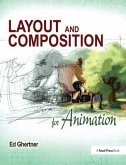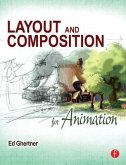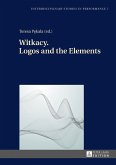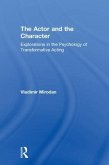- Gebundenes Buch
- Merkliste
- Auf die Merkliste
- Bewerten Bewerten
- Teilen
- Produkt teilen
- Produkterinnerung
- Produkterinnerung
As a professional, understanding the foundations of drawing, how we process images, and how we interpret what we see are principal skills. This book is an essential visual guide for current and future architects, interior designers, landscape architects, graphic designers, video game designers, animators, and artists.
Andere Kunden interessierten sich auch für
![Layout and Composition for Animation Layout and Composition for Animation]() Ed GhertnerLayout and Composition for Animation178,99 €
Ed GhertnerLayout and Composition for Animation178,99 €![Layout and Composition for Animation Layout and Composition for Animation]() Ed GhertnerLayout and Composition for Animation49,99 €
Ed GhertnerLayout and Composition for Animation49,99 €![Witkacy. Logos and the Elements Witkacy. Logos and the Elements]() Witkacy. Logos and the Elements80,20 €
Witkacy. Logos and the Elements80,20 €![The Actor and the Character The Actor and the Character]() Vladimir MirodanThe Actor and the Character174,99 €
Vladimir MirodanThe Actor and the Character174,99 €![To The Actor To The Actor]() Michael ChekhovTo The Actor19,99 €
Michael ChekhovTo The Actor19,99 €![The Art of Star Wars: The High Republic The Art of Star Wars: The High Republic]() Kristin BaverThe Art of Star Wars: The High Republic32,99 €
Kristin BaverThe Art of Star Wars: The High Republic32,99 €![The Art of Star Wars: The Mandalorian (Season One) The Art of Star Wars: The Mandalorian (Season One)]() Phil SzostakThe Art of Star Wars: The Mandalorian (Season One)24,99 €
Phil SzostakThe Art of Star Wars: The Mandalorian (Season One)24,99 €-
-
-
As a professional, understanding the foundations of drawing, how we process images, and how we interpret what we see are principal skills. This book is an essential visual guide for current and future architects, interior designers, landscape architects, graphic designers, video game designers, animators, and artists.
Produktdetails
- Produktdetails
- Verlag: Taylor & Francis Ltd
- 2. Auflage
- Seitenzahl: 352
- Erscheinungstermin: 15. Dezember 2025
- Englisch
- Abmessung: 280mm x 210mm
- ISBN-13: 9781032784830
- ISBN-10: 1032784830
- Artikelnr.: 74443746
- Herstellerkennzeichnung
- Libri GmbH
- Europaallee 1
- 36244 Bad Hersfeld
- gpsr@libri.de
- Verlag: Taylor & Francis Ltd
- 2. Auflage
- Seitenzahl: 352
- Erscheinungstermin: 15. Dezember 2025
- Englisch
- Abmessung: 280mm x 210mm
- ISBN-13: 9781032784830
- ISBN-10: 1032784830
- Artikelnr.: 74443746
- Herstellerkennzeichnung
- Libri GmbH
- Europaallee 1
- 36244 Bad Hersfeld
- gpsr@libri.de
Craig Attebery is a native southern Californian. He Graduated from ArtCenter College of Design in 1980, receiving a BFA with Honors. He then completed his MFA studies at Otis/Parsons Art Institute in 1984. Craig has worked as a freelance illustrator for advertising agencies, science books, and the entertainment industry, as well as creating conceptual art for JPL/NASA and the aerospace industry. Craig's illustrations have appeared in many publications including Newsweek and Time magazine. In addition to his commercial work, he has participated in exhibitions at galleries and museums throughout the country and internationally, including the Fry Museum (Seattle, WA), the Arnot Museum (Elmira, NY), the Art Museum of South Texas (Corpus Christi, TX), and the Oceanside Museum (Oceanside, CA). His work is in the permanent collection of the de Young Museum (San Francisco, CA). Craig is a faculty member at ArtCenter College of Design where he has taught perspective for over 20 years.
Introduction Tools of the Trade Part 1: The Basics 1.Basic Perspective Terms 2. One
Through Six
Point Perspective, an Overview Part 2: One
Point 3. One
Point Perspective Part 3: Reference Points 4. Reference Points Part 4: Two
Point 5. Two
Point Perspective 6. Measuring Point Geometry 7. Horizontal Angles Part 5: Ellipses 8. Ellipses, Spheres, Spiral Forms, and Random Curves Part 6: Inclines 9.Inclined Planes 10.Inclined Cuboids 11. Incline Geometry 12. The Problem of Distant Vanishing points 13. Falling and Rotating Forms 14.Tilted Tapered Forms Part 7: Plan/Elevation View Perspective 15. Plan/Elevation View Perspective Part 8: Three
Point 16. Three
Point Perspective 17.Three
Point Angles 18. Combining One
and Three
Point Perspective 19. Combining Two
and Three
Point Perspective 20. Combining Three
Point Perspective Diagrams 21. Compound Inclines in Two
Point Perspective Part 9: Shadows 22. Shadows 23.Shadows of Round, Spherical, and Curved Objects 24. Positive Shadows 25. Negative Shadows 26. Shadows from Artificial Light Sources 27. Three
Point Shadows Part 10: Reflections 28. Reflections 29. Reflections on Curved Surfaces Part 11: Anamorphic Perspective 30. Anamorphic Perspective Part 12: Curvilinear Perspective 31. Four
Point Perspective 32. Five
Point Perspective 33. Six
Point Perspective Part 13: Miscellaneous 34. Miscellaneous
Through Six
Point Perspective, an Overview Part 2: One
Point 3. One
Point Perspective Part 3: Reference Points 4. Reference Points Part 4: Two
Point 5. Two
Point Perspective 6. Measuring Point Geometry 7. Horizontal Angles Part 5: Ellipses 8. Ellipses, Spheres, Spiral Forms, and Random Curves Part 6: Inclines 9.Inclined Planes 10.Inclined Cuboids 11. Incline Geometry 12. The Problem of Distant Vanishing points 13. Falling and Rotating Forms 14.Tilted Tapered Forms Part 7: Plan/Elevation View Perspective 15. Plan/Elevation View Perspective Part 8: Three
Point 16. Three
Point Perspective 17.Three
Point Angles 18. Combining One
and Three
Point Perspective 19. Combining Two
and Three
Point Perspective 20. Combining Three
Point Perspective Diagrams 21. Compound Inclines in Two
Point Perspective Part 9: Shadows 22. Shadows 23.Shadows of Round, Spherical, and Curved Objects 24. Positive Shadows 25. Negative Shadows 26. Shadows from Artificial Light Sources 27. Three
Point Shadows Part 10: Reflections 28. Reflections 29. Reflections on Curved Surfaces Part 11: Anamorphic Perspective 30. Anamorphic Perspective Part 12: Curvilinear Perspective 31. Four
Point Perspective 32. Five
Point Perspective 33. Six
Point Perspective Part 13: Miscellaneous 34. Miscellaneous
Preface. Introduction. List of Abbreviations. 1. Basic Perspective Terms. 2. One- through Six-Point perspective an Overview. 3. One-Point Perspective. 4. Reference Points. 5. Two-Point Perspective. 6. Measuring Point Geometry. 7. Horizontal Angles. 8. Ellipses, Spheres, Spiral Forms, and Random Curves. 9. Inclined Planes. 10. Inclined Cuboids. 11. Incline Geometry. 12. The Problem of Distant Vanishing points. 13. Falling and Rotating Forms. 14. Tilted Tapered Forms. 15. Perspective in the 1400s. 16. Plan/Elevation View Perspective. 17. Three-Point Perspective. 18. Three-Point Angles. 19. Combining One- and Three-Point Perspective. 20. Combining Two- and Three-Point Perspective. 21. Combining Three-Point Perspective Diagrams. 22. Compound Inclines in Two-Point Perspective. 23. Shadows. 24. Shadows of Round, Spherical, and Curved Objects. 25. Positive Shadows. 26. Negative Shadows. 27. Shadows from Artificial Light Sources. 28. Three-Point Shadows. 29. Reflections. 30. Reflections on Inclined Surfaces. 31. Reflections on Curved Surfaces. 32. Anamorphic Perspective. 33. Four-Point Perspective. 34. Five-Point Perspective. 35. Six-Point Perspective. 36. Miscellaneous. Glossary. Bibliography. Index.
Introduction Tools of the Trade Part 1: The Basics 1.Basic Perspective Terms 2. One
Through Six
Point Perspective, an Overview Part 2: One
Point 3. One
Point Perspective Part 3: Reference Points 4. Reference Points Part 4: Two
Point 5. Two
Point Perspective 6. Measuring Point Geometry 7. Horizontal Angles Part 5: Ellipses 8. Ellipses, Spheres, Spiral Forms, and Random Curves Part 6: Inclines 9.Inclined Planes 10.Inclined Cuboids 11. Incline Geometry 12. The Problem of Distant Vanishing points 13. Falling and Rotating Forms 14.Tilted Tapered Forms Part 7: Plan/Elevation View Perspective 15. Plan/Elevation View Perspective Part 8: Three
Point 16. Three
Point Perspective 17.Three
Point Angles 18. Combining One
and Three
Point Perspective 19. Combining Two
and Three
Point Perspective 20. Combining Three
Point Perspective Diagrams 21. Compound Inclines in Two
Point Perspective Part 9: Shadows 22. Shadows 23.Shadows of Round, Spherical, and Curved Objects 24. Positive Shadows 25. Negative Shadows 26. Shadows from Artificial Light Sources 27. Three
Point Shadows Part 10: Reflections 28. Reflections 29. Reflections on Curved Surfaces Part 11: Anamorphic Perspective 30. Anamorphic Perspective Part 12: Curvilinear Perspective 31. Four
Point Perspective 32. Five
Point Perspective 33. Six
Point Perspective Part 13: Miscellaneous 34. Miscellaneous
Through Six
Point Perspective, an Overview Part 2: One
Point 3. One
Point Perspective Part 3: Reference Points 4. Reference Points Part 4: Two
Point 5. Two
Point Perspective 6. Measuring Point Geometry 7. Horizontal Angles Part 5: Ellipses 8. Ellipses, Spheres, Spiral Forms, and Random Curves Part 6: Inclines 9.Inclined Planes 10.Inclined Cuboids 11. Incline Geometry 12. The Problem of Distant Vanishing points 13. Falling and Rotating Forms 14.Tilted Tapered Forms Part 7: Plan/Elevation View Perspective 15. Plan/Elevation View Perspective Part 8: Three
Point 16. Three
Point Perspective 17.Three
Point Angles 18. Combining One
and Three
Point Perspective 19. Combining Two
and Three
Point Perspective 20. Combining Three
Point Perspective Diagrams 21. Compound Inclines in Two
Point Perspective Part 9: Shadows 22. Shadows 23.Shadows of Round, Spherical, and Curved Objects 24. Positive Shadows 25. Negative Shadows 26. Shadows from Artificial Light Sources 27. Three
Point Shadows Part 10: Reflections 28. Reflections 29. Reflections on Curved Surfaces Part 11: Anamorphic Perspective 30. Anamorphic Perspective Part 12: Curvilinear Perspective 31. Four
Point Perspective 32. Five
Point Perspective 33. Six
Point Perspective Part 13: Miscellaneous 34. Miscellaneous
Preface. Introduction. List of Abbreviations. 1. Basic Perspective Terms. 2. One- through Six-Point perspective an Overview. 3. One-Point Perspective. 4. Reference Points. 5. Two-Point Perspective. 6. Measuring Point Geometry. 7. Horizontal Angles. 8. Ellipses, Spheres, Spiral Forms, and Random Curves. 9. Inclined Planes. 10. Inclined Cuboids. 11. Incline Geometry. 12. The Problem of Distant Vanishing points. 13. Falling and Rotating Forms. 14. Tilted Tapered Forms. 15. Perspective in the 1400s. 16. Plan/Elevation View Perspective. 17. Three-Point Perspective. 18. Three-Point Angles. 19. Combining One- and Three-Point Perspective. 20. Combining Two- and Three-Point Perspective. 21. Combining Three-Point Perspective Diagrams. 22. Compound Inclines in Two-Point Perspective. 23. Shadows. 24. Shadows of Round, Spherical, and Curved Objects. 25. Positive Shadows. 26. Negative Shadows. 27. Shadows from Artificial Light Sources. 28. Three-Point Shadows. 29. Reflections. 30. Reflections on Inclined Surfaces. 31. Reflections on Curved Surfaces. 32. Anamorphic Perspective. 33. Four-Point Perspective. 34. Five-Point Perspective. 35. Six-Point Perspective. 36. Miscellaneous. Glossary. Bibliography. Index.
"Full of very clear illustrations with a straightforward text, knowledge of algebra and geometry is not required. [...] This is an excellent guide that is easy to use. It is well laid out, allowing information to be easily accessed."
Ray Needham FAIA FFA FIPA FMAAT, Building Engineer, September 2018
Ray Needham FAIA FFA FIPA FMAAT, Building Engineer, September 2018








